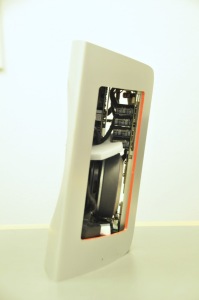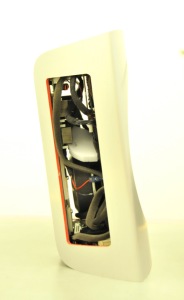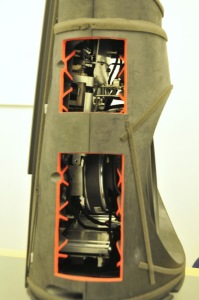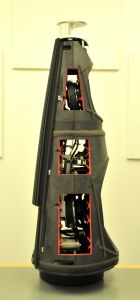#29 in a series of articles about the technology behind Bang & Olufsen loudspeakers
Sorry – I’ve been busy lately, so I haven’t been too active on the blog.
Here are some internal shots of the BeoLab 17 and BeoLab 20 loudspeakers. As you can see in the shot of the back of the BeoLab 17, the entire case is the enclosure is for the woofer. The tweeter has its own enclosure which seals it from the woofer cabinet.
What’s not obvious in the photos of the BeoLab 20 is that the midrange and woofer cabinets are separate sealed boxes. There is a bulkhead that separates the two enclosures cutting across the loudspeaker just below the midrange driver.









Mattias says:
You forgot to mention which products you’ve been busy with. Or maybe you didn’t. ;)
Mattias says:
In the BeoLab 17, it seems the speaker units and all the innards are attached to the moulded plastic part which is the attached to the aluminium skin. Is that approach beneficial for the sound performance (as opposed to having an aluminium-only structure), or is more a necessity from a cost/production perspective?
Millemissen says:
Geoff has probably been busy wrapping up gifts for us all ;-)
Good to hear from you again – anyway.
geoff says:
Hi Mattias,
Sorry to be so late responding to your question…
The construction materials of any loudspeaker in the B&O portfolio is decided by balancing the acoustical and mechanical vibration requirements against the cost, manufacturing considerations (i.e. time), and performance issues (i.e. heat dissapation). In cases where the it more cost-efficient to make a loudspeaker out of moulded plastic, it may be necessary (for example) to use plastic with glass fibres in the mix (to stiffen the structure) and/or with the adequate placement of ribbing (as you can see in the BeoLab 20 cutaways.
This is described in part in one of my previous postings here.
You may see/hear other companies or persons make much noise about the materials used in loudspeaker (or loudspeaker driver) construction. There is no simple solution where one material is good and another is bad for this purpose. The question is whether the material used for the construction meets the requirements for the loudspeaker. So, plastic is as good (perhaps better) than aluminium in some cases, where done properly. In other cases, aluminium is better than plastic. It’s not a simple if-then statement – it’s an “it depends” statement.
Cheers
-geoff
Jean-Michel Guillot says:
Hi Geoff
As far as I can see, there is hardly any damping material in both Blab 17 and Blab 20.
Why is that? I’ve always believed that damping is mostly important regarding elimination of “box sound” and other unwanted/uncontrolled sound waves. Please explain…
Thanks
Jean-Michel
geoff says:
Hi Jean-Michel,
Damping helps to reduces internal resonances in a sealed cabinet loudspeaker which causes the “box sound”. However, if you can control the phase of the driver by frequency, then you can also cancel these resonances using DSP filtering – which is what we do. Of course, damping materials never hurt when it comes to reducing ringing in the cabinet. It also makes the driver behave as if the enclosure were larger. However, damping materials also reduce the flow of air through the cabinet which helps with heat dispersion – and this is a large consideration for us, since the power supply, amplifiers and drivers share the same cabinet in the BL17 and 20.
So, we have to balance between dealing with resonances (which we can also accomplish in the DSP) and sources of heat.
You’ll notice that the 17 has a piece of fuzzy stuff half-way through the cabinet. This is strategically placed – sound absorption works most effectively when you’re in a location with maximum particle velocity instead of particle pressure. You also get to use both sides of the fuzzy stuff, instead of just one, which helps!
So, if we made passive loudspeakers, we’d probably be using a lot more damping materials – because we’d need it a lot more…
Hope this helps.
Cheers
-geoff